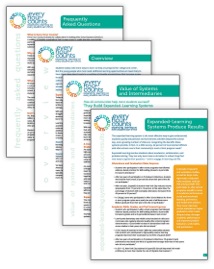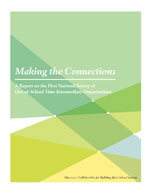Have you ever sat down with your schools superintendent or local funder, or even that person sitting next to you on the plane, and struggled to describe exactly what an “after-school system” is? Or “intermediary?” Or “expanded-learning?” We have, too, and frankly, we realized it was time for a change – a bold change. A rethinking of how we communicate the value of what we do, in clear and compelling language. Through a comprehensive messaging planning process, we learned a few lessons for talking about our work:
• Focus on outcomes and impact, rather than process.
• Use language that makes sense to external audiences.
• Tell key audiences what’s in it for them.
 What are the big changes we made? For one, we changed our name to Every Hour Counts, formerly the Collaborative for Building After-School Systems. Why the change? Across the nation, our partners and peer organizations are employing an impressive range of strategies to provide all students with additional learning opportunities. We needed a new name that captured the power of expanded learning. Plus, Every Hour Counts is sticky, aspirational, speaks to high-quality programs, and conveys urgency. Our mission remains the same: expanding learning so every student can thrive.
What are the big changes we made? For one, we changed our name to Every Hour Counts, formerly the Collaborative for Building After-School Systems. Why the change? Across the nation, our partners and peer organizations are employing an impressive range of strategies to provide all students with additional learning opportunities. We needed a new name that captured the power of expanded learning. Plus, Every Hour Counts is sticky, aspirational, speaks to high-quality programs, and conveys urgency. Our mission remains the same: expanding learning so every student can thrive.
Instead of adopting more lay terms, we decided to embrace the words “system” and “intermediary,” but to do a better job defining them and highlighting the benefits of building systems and supporting intermediaries.
We’re bringing complex ideas in system-building, such as quality improvement and school and community partnerships, to life through storytelling.
We compiled results – academic, social, and emotional – with robust data to show how expanded-learning systems drive youth impact.
All these messaging tools are available freely on our website, and we hope you use them. Adopt the language in your own communications, use it in blogs, and share the tools with others. As Andrea Sussman of KSA-Plus Communications pointed out to participants in our recent webinar on messaging, “You have way more in common with one another than you have with the people you want to convince. You are trying to win hearts and change minds. And you do that by banding together and using the power of your collective voice.”
The more voices there are in the field speaking the same language, the farther we’ll all go to make every hour count.
To learn more, watch to our recent webinar, “Steal this Message: Explaining the Value of Expanded-Learning Systems and Intermediaries.”
Let us know what you think and please stay in touch.

